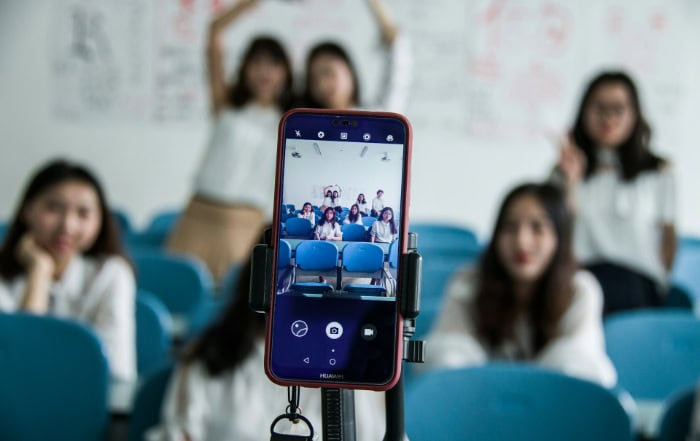Should Cell Phones Be Allowed in School? The Debate

Classrooms across the nation face a modern dilemma: the presence of cell phones. These pocket-sized devices, once solely for communication, now offer a world of information at students' fingertips.
The debate over allowing phones in schools has intensified, dividing educators, parents, and students alike. Proponents argue that phones enhance safety and provide valuable learning tools, while critics warn of distractions and potential misuse.
As technology continues to advance, schools must adapt their policies to address this issue. The decision carries weight, influencing not only academic performance but also social dynamics and future workforce readiness.
By examining the pros and cons, we can better understand the complexities of integrating cell phones into the educational landscape and work towards solutions that benefit all stakeholders.
The Case for Allowing Cell Phones in School
The debate surrounding cell phones in schools often focuses on their potential drawbacks, but there are compelling arguments in favor of allowing these devices in educational settings. Proponents argue that cell phones can enhance communication, safety, and learning opportunities while preparing students for a technology-driven future.
Enhanced Communication and Safety
One of the primary arguments for allowing cell phones in school is the improved communication and safety they provide. In emergency situations, students can quickly contact their parents or guardians, alleviating anxiety and ensuring prompt responses to urgent matters.
This direct line of communication can be crucial during unexpected events or changes in schedules.
Moreover, cell phones offer immediate access to emergency services. In critical situations, such as medical emergencies or security threats, students and staff can swiftly call for help.
This rapid response capability can potentially save lives and minimize the impact of dangerous situations.
Educational Benefits
Cell phones have evolved into powerful learning tools that can significantly enhance the educational experience. Students can access a vast array of online resources and information, supplementing their textbooks and classroom materials.
This instant access to knowledge allows for deeper exploration of subjects and encourages self-directed learning.
Additionally, numerous educational apps and tools have been developed specifically for mobile devices. These applications can make learning more interactive, engaging, and personalized.
From language learning apps to scientific calculators and virtual field trip experiences, cell phones can transform how students interact with educational content.
Preparation for the Digital World
Allowing cell phones in school provides students with valuable opportunities to develop essential digital literacy skills. As technology continues to play an increasingly significant role in various professions, students who are comfortable using mobile devices for research, communication, and problem-solving will be better prepared for their future careers.
Furthermore, integrating cell phones into the educational environment allows schools to teach responsible technology use. By guiding students on appropriate cell phone etiquette, digital citizenship, and online safety, educators can help shape responsible digital citizens.
This proactive approach equips students with the skills to navigate the digital landscape ethically and effectively, both in and out of the classroom.
Arguments Against Cell Phones in School

While cell phones offer potential benefits in educational settings, there are significant concerns about their presence in schools. Critics argue that these devices can negatively impact learning, social interactions, and academic integrity.
These arguments form the basis for policies that restrict or ban cell phone use in many educational institutions.
Distraction and Reduced Focus
One of the primary arguments against allowing cell phones in school is their potential to distract students and reduce focus during lessons. The constant connectivity and notifications from social media, messaging apps, and games can pull students' attention away from classroom activities and discussions.
This distraction can significantly impact classroom engagement. Students may be physically present but mentally absent, scrolling through their phones instead of participating in lessons or group work.
Teachers often find themselves competing with digital devices for students' attention, making it challenging to maintain an effective learning environment.
The consequences of these distractions can extend beyond the classroom, potentially leading to decreased academic performance. When students are not fully engaged in lessons, they may miss important information, struggle to grasp complex concepts, or fail to develop critical thinking skills.
This lack of focus can result in lower grades and a diminished overall learning experience.
Cyberbullying and Social Issues
The presence of cell phones in schools can exacerbate social issues, particularly cyberbullying. With constant access to social media and messaging platforms, students have more opportunities to engage in or become victims of online harassment.
This digital bullying can occur during school hours, creating a hostile environment that extends beyond the physical classroom.
Cyberbullying can have severe consequences for students' mental health and well-being. Victims may experience anxiety, depression, and a decline in academic performance.
The anonymity and reach of digital platforms can make these attacks particularly harmful and difficult to address.
Moreover, the prevalence of cell phones can negatively affect face-to-face social interactions. Students may become overly reliant on digital communication, leading to decreased development of interpersonal skills.
The art of conversation, reading body language, and building in-person relationships may suffer as students prioritize virtual interactions over real-world connections.
Cheating Concerns
Cell phones in schools raise significant concerns about academic integrity. These devices provide easy access to information during exams, tempting students to cheat.
With a wealth of knowledge at their fingertips, students may be inclined to look up answers or access prohibited resources during tests, compromising the fairness and validity of assessments.
Additionally, messaging apps on cell phones enable students to share answers quickly and discreetly. This capability makes it challenging for teachers to monitor and prevent cheating, potentially undermining the entire evaluation process.
As a result, grades may not accurately reflect students' knowledge and abilities, leading to inflated scores and a false sense of achievement.
The prevalence of cheating through cell phones can also create an unfair advantage for students who choose to use their devices dishonestly. This situation can demoralize honest students and erode the overall academic culture of the school.
Addressing these cheating concerns often requires implementing strict policies and monitoring systems, which can be resource-intensive for schools to maintain.
Impact on Student Well-being

The debate over cell phones in schools extends beyond academic considerations to encompass the overall well-being of students. The presence of these devices can significantly affect both mental and physical health, raising important questions about the long-term consequences of their use in educational settings.
Mental Health Considerations
The constant connectivity provided by cell phones can have profound effects on students' mental health. While staying connected can be beneficial in some ways, it also introduces new sources of stress and anxiety that can impact students' emotional well-being and academic performance.
One of the primary concerns is the anxiety and stress related to constant connectivity. Students may feel pressured to be available and responsive at all times, leading to a sense of being overwhelmed.
This constant state of alertness can interfere with their ability to focus on schoolwork, engage in face-to-face interactions, or simply relax and recharge.
Another significant issue is the phenomenon known as FOMO, or Fear of Missing Out. Social media platforms, easily accessible through cell phones, can create a persistent worry that others are having more enjoyable experiences or leading more exciting lives.
This fear can lead to compulsive checking of social media, feelings of inadequacy, and a distorted perception of reality.
Social media pressure also plays a role in students' mental health. The curated nature of online profiles can create unrealistic expectations and foster unhealthy comparisons.
Students may feel compelled to present a perfect image online, leading to anxiety about their appearance, achievements, and social status. This pressure can contribute to low self-esteem, depression, and other mental health issues.
Physical Health Concerns
While the mental health impacts of cell phone use in schools are significant, the physical health concerns should not be overlooked. Prolonged use of these devices can lead to various physical ailments that may affect students' overall well-being and academic performance.
Eye strain is a common issue associated with frequent cell phone use. The small screens and often poor lighting conditions can cause students to squint or strain their eyes, potentially leading to headaches, blurred vision, and long-term vision problems.
Additionally, the blue light emitted by cell phone screens can disrupt sleep patterns, affecting students' ability to rest and recover properly.
Posture issues are another concern related to cell phone use in schools. Students often hunch over their devices, leading to poor posture and potential long-term musculoskeletal problems.
This “text neck” phenomenon can cause neck pain, shoulder strain, and back problems, which may persist into adulthood if not addressed.
The potential long-term effects of radiation exposure from cell phones have also been a topic of discussion. While current research has not conclusively proven harmful effects from the low levels of radiofrequency radiation emitted by cell phones, some experts advocate for a precautionary approach, especially when it comes to children and adolescents whose bodies are still developing.
Excessive cell phone use can also lead to a more sedentary lifestyle. Students may spend less time engaging in physical activities or sports, opting instead to spend their free time on their devices.
This reduction in physical activity can contribute to obesity, cardiovascular issues, and other health problems associated with a lack of exercise.
Policy Approaches and Implementation
As schools grapple with the cell phone debate, various policy approaches have emerged to address the challenges and opportunities presented by these devices. The implementation of these policies requires careful consideration of the school's unique needs, resources, and educational goals.
Complete Ban vs. Restricted Use
Schools typically adopt one of two main approaches to cell phone policies a complete ban or restricted use. Each approach has its own set of advantages and drawbacks, and the effectiveness of either policy often depends on how well it is implemented and enforced.
A complete ban on cell phones in schools aims to eliminate distractions entirely. This approach can create a more focused learning environment, reduce instances of cyberbullying during school hours, and minimize cheating concerns.
It also promotes face-to-face interactions among students and can help develop better interpersonal skills. However, enforcing a total ban can be challenging and resource-intensive.
It may also deprive students of potential learning opportunities and emergency communication capabilities.
On the other hand, restricted use policies allow cell phones on campus but limit their use to specific times or areas. This approach acknowledges the potential benefits of cell phones while attempting to mitigate their negative impacts.
Restricted use can teach students responsible device management and prepare them for real-world scenarios where they'll need to balance technology use with other activities. However, this policy requires clear guidelines and consistent enforcement, which can be difficult to maintain.
Some schools have successfully implemented hybrid approaches. For example, a school might ban cell phones in classrooms but allow their use during lunch breaks or in designated areas.
Another approach is to permit cell phones for specific educational activities under teacher supervision. These nuanced policies can provide a balance between the benefits and drawbacks of cell phone use in schools.
Integrating Phones into the Curriculum
As technology continues to advance, many educators are exploring ways to integrate cell phones into the curriculum as learning tools. This approach aims to harness the educational potential of these devices while teaching responsible use.
One strategy for using phones as learning tools is to incorporate educational apps and online resources into lessons. Teachers can guide students to use their devices for research, interactive quizzes, or collaborative projects.
This approach can make learning more engaging and help students develop digital literacy skills.
Another strategy is to use cell phones for multimedia projects. Students can use their devices to create videos, podcasts, or digital presentations, fostering creativity and technical skills.
Additionally, phones can be used for real-time polling or feedback during class discussions, encouraging participation and providing immediate assessment data for teachers.
Successful integration of cell phones into the curriculum requires comprehensive teacher training and support. Educators need to be familiar with the latest educational apps and technologies, as well as strategies for managing device use in the classroom.
Professional development programs can help teachers learn how to create lesson plans that effectively incorporate cell phones and address potential challenges such as equity issues for students who may not have access to smartphones.
Schools implementing phone-friendly policies should also provide technical support for both teachers and students. This might include assistance with app installations, troubleshooting connectivity issues, and ensuring data privacy and security.
Additionally, schools may need to invest in infrastructure upgrades, such as improved Wi-Fi networks, to support increased device usage.
Balancing Technology and Traditional Learning

As schools navigate the integration of cell phones and other digital devices into the educational environment, it's crucial to maintain a balance between technological advancements and traditional learning methods. This balance ensures that students develop a well-rounded skill set, combining digital literacy with fundamental cognitive abilities and social skills.
Developing Critical Thinking Skills
While technology offers numerous benefits, it's essential to recognize the importance of offline learning experiences in developing critical thinking skills. These experiences provide students with opportunities to engage deeply with content, analyze information, and form independent conclusions without the immediate assistance of digital tools.
Offline learning activities, such as group discussions, hands-on experiments, and paper-based problem-solving exercises, encourage students to rely on their own cognitive abilities. These activities foster skills like logical reasoning, analytical thinking, and creative problem-solving.
By engaging in these traditional learning methods, students learn to approach challenges from multiple angles and develop the ability to think critically without depending on instant information access.
Encouraging creativity and problem-solving without technology is another crucial aspect of balanced learning. Activities such as brainstorming sessions, art projects, and open-ended problem-solving tasks allow students to tap into their imagination and develop innovative solutions.
These experiences help students build confidence in their own abilities and learn to trust their instincts, skills that are valuable in both academic and real-world settings.
Moreover, offline learning experiences often involve face-to-face interactions, which are essential for developing social and emotional intelligence. Group projects, debates, and collaborative problem-solving exercises help students learn to communicate effectively, work in teams, and understand different perspectives.
These interpersonal skills are crucial for success in both personal and professional life, and they complement the digital skills students acquire through technology use.
Teaching Responsible Phone Use
As cell phones become increasingly prevalent in schools, it's vital to teach students how to use these devices responsibly. This education goes beyond simply instructing students on when and where to use their phones; it involves cultivating a deeper understanding of digital citizenship and developing self-regulation skills.
Digital citizenship education is a fundamental component of responsible phone use. This curriculum should cover topics such as online safety, privacy protection, and ethical behavior in digital spaces.
Students need to learn about the potential consequences of their online actions, including the long-term implications of social media posts and the importance of respecting others' digital rights and property.
Additionally, digital citizenship education should address issues like information literacy and critical evaluation of online sources. Students must learn how to distinguish between reliable and unreliable information, recognize bias, and fact-check claims they encounter online.
These skills are essential in an era where misinformation can spread rapidly through digital channels.
Setting boundaries and developing self-regulation skills are equally important aspects of responsible phone use. Students need guidance on how to manage their screen time, avoid digital distractions during study periods, and maintain a healthy balance between online and offline activities.
Teaching techniques like the Pomodoro method or encouraging the use of app-blocking software can help students develop these self-regulation skills.
Schools can also implement strategies to help students recognize the signs of excessive phone use or digital addiction. This might include educating students about the potential negative impacts of overuse on mental health, sleep patterns, and academic performance.
By fostering awareness of these issues, schools can empower students to make informed decisions about their technology use.
Ultimately, the goal of teaching responsible phone use is to equip students with the skills and knowledge they need to navigate the digital world safely and effectively.
Conclusion
Cell phones in schools present both opportunities and challenges for educators, students, and parents. These devices offer enhanced communication, safety benefits, and educational tools, while also raising concerns about distractions, cyberbullying, and academic integrity.
Mental and physical health considerations further complicate the issue. Successful policies strike a balance between harnessing technology's potential and preserving traditional learning methods.
Schools must develop strategies that integrate phones responsibly, teach digital citizenship, and foster critical thinking skills. A nuanced approach, tailored to each school's unique needs, can maximize benefits while minimizing drawbacks.
Regular assessment and adaptation of these policies remain crucial as technology evolves, ensuring that educational practices stay relevant and effective in preparing students for their future.


